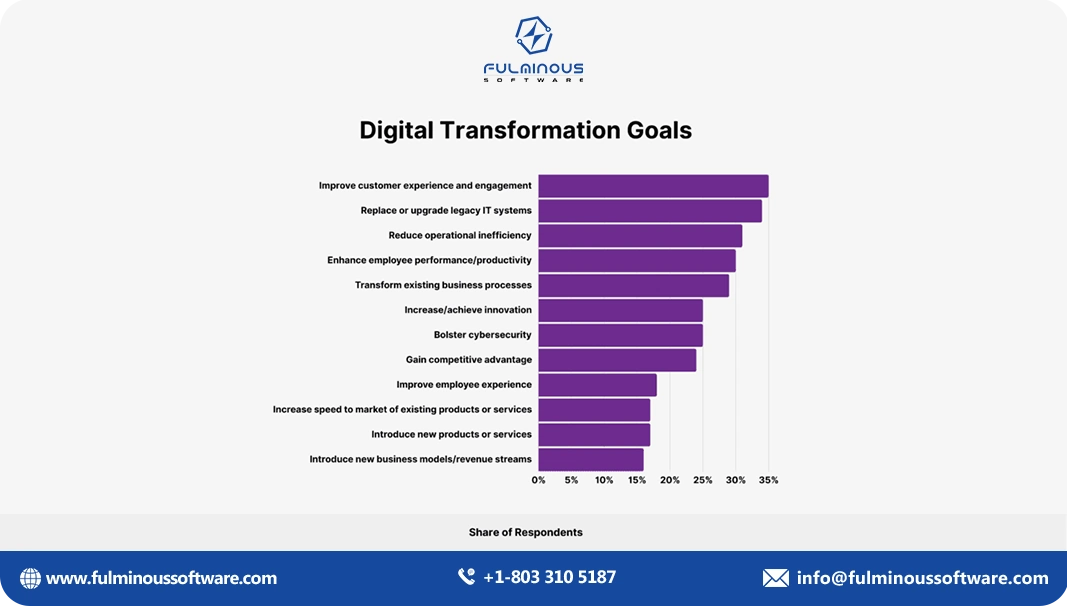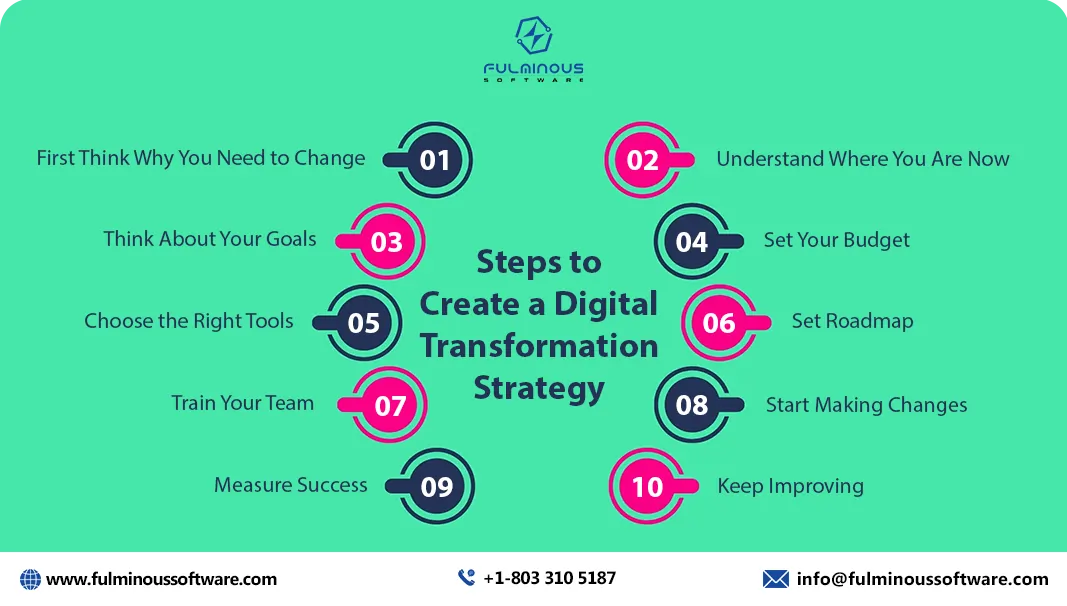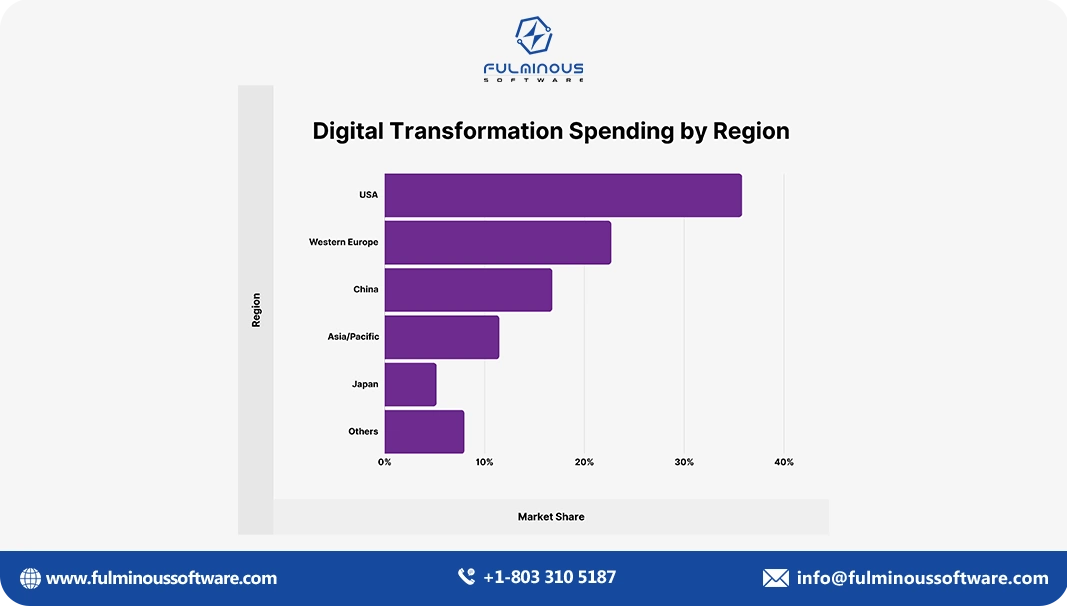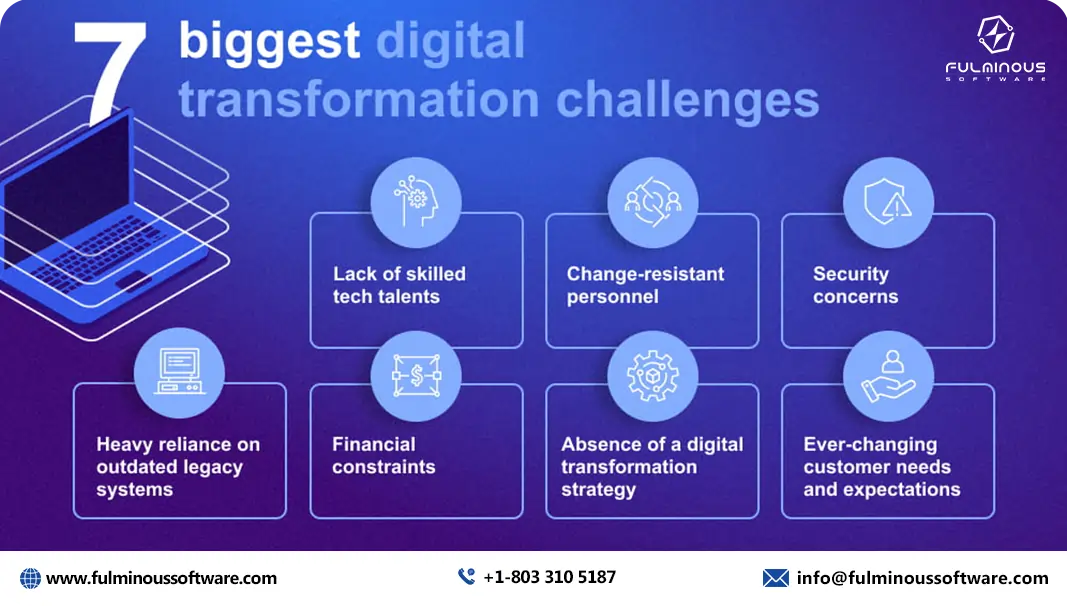How to Create a Digital Transformation Strategy?
Manish Kumawat
Last Updated on: 07 October 2025
Everyone knows strategies are a set of specific plans of action to achieve some targets. The term strategy itself reminds us of the need for creativity and careful planning. In today’s world, things that seemed impossible just a few years ago are now happening. So you need a better plan to always succeed. Digital transformation is a critical step for businesses seeking growth in the modern world. In this article, we will guide you on how to create a digital transformation strategy that aligns with your company’s vision and objectives.
For example, people can use their phones to order food, talk to anyone across the world, or even learn new things without leaving their homes. Just think how much ROI was generated by the pioneers of these ideas and businesses that integrated those ideas. When you ask them, they will say that we had a clear plan since the beginning.

One big word you might hear when people talk about technology is Digital Transformation. Even though the term sounds like a complicated one, in simple words, it just means making things better using technology. When you adapt to these changes, you need a better strategy. The following data will amaze you:
- Digital transformation is ranked as a top priority in their firms by 61% of company executives. ( source )
- 94% of big businesses in the US and the UK have a plan in place for digital transformation. ( source )
- According to 81% of corporate executives, making investments in digital transformation is either necessary or crucial for attaining company success. ( source )
- For 74% of firms, digital transformation is a crucial technology initiative. ( source )
- ROI for digital transformation projects has beyond expectations, according to 56% of US executives. ( source )
- 58% of businesses want to spend more money this year than they did last year on digital transformation projects. ( source )
- Digital transformation initiatives have improved performance over the last two years, according to 63% of CEOs worldwide. ( source )
Yes, it's relevant, but how do we create a Digital Transformation Strategy? In this blog, we’ll explain how to do this step by step so anyone, even a child, can understand.
Why is a Digital Transformation Strategy Important?
A strategy is like a plan. When we want to do something big and important, we need a plan to know what to do first, second, and so on. Imagine you are building a treehouse. You need a plan so that you don’t forget anything, like how to put the walls together, where the windows should go, and how to get up there!

In the same way, when a business wants to use digital technology to improve, they need a digital transformation strategy. It helps them know:
- Where to Start: What’s the first thing they should change?
- How to Change: What tools and technology should they use?
- What to Do Afterward: Once the changes are made, how do they make sure it all works?
Steps for How to Create a Digital Transformation Strategy

Here we will see the how to create a Digital Transformation Strategy:
1. First, Think Why You Need to Change
Before you start making any changes, you need to stop and think about why you want to do it. Understanding how to create a digital transformation strategy is crucial, as it will guide you through the process. When you go ahead with digital transformation, you may face various challenges. This clarification about why you stepped in is the key motivation that helps you in each stage of digital transformation.
In a manufacturing business, you are already invested in various areas like machinery, manpower, energy, and so on. Before investing in a new initiative, you must seek this clarification. Get clarification on things like:
- Does it help business expansion?
- How much will be ROI?
- What is its overall benefit?
- How does this help my production process?
- Are you trying to make things easier?
- Do you want to sell more things?
Once you know why you want to change, you can start thinking about the next step. Nobody or no challenges can stop you. If you don't know why you need to change, it can be hard to make the right decisions. Remember, you need to ask these questions each time you make changes in your digital realm.
2. Understand Where You Are Now
The next step is to evaluate your manufacturing business's current status. As we say in general, admitting our weaknesses and willingness to change is key to digital transformation. The reality is that nobody else knows the current state of your manufacturing business better than you do.
You need to check how things are working in your manufacturing factory. Remember, don't miss any single area, whether it's project management, production, security, downtime, costs, and so on. If you want to get better, you first need to know how well you are doing. Are you already good at it, or do you need a lot of improvement?
For example, if you are running a factory and still write down orders with paper and pen, it may take longer to keep track of everything. But if you use a computer or an app, it might make things faster and easier. So, it's important to see where you are before you start.
Ask yourself: What tools am I using now? Are you in the 90s? Do you have a website, or do customers need to visit your store? As you have decided to change, no harm in admitting your weaknesses. Also, think about how your whole team is working. This is important because if your team is not comfortable or happy with the tools they are using, it could be harder to make changes.
3. Think About Your Goals
As you have already evaluated where you are now, the next task is to decide where you want to reach. Without a target for what you want to achieve, you may wander here and there, and also lose effort, money, and energy.
In business, your goal could be anything you want to improve. For example, if you run a bakery and want more people to order cakes, your goal might be to create a website where customers can place their orders online. If you want to make your team's work easier, your goal might be to use software that helps you keep track of orders.
Even though you set a goal in the initial stage, you may have to upgrade it in the later stage. Because as the competition in your manufacturing industry changes, you need to adjust accordingly.
Ask these questions to yourself:
- Do I want to help more people buy my products?
- Do I want my team to work faster and easier?
- Do I want to save time or money?
Without clear goals, it's easy to get confused or distracted. Clear goals make everything easier and help you know when you have succeeded!
4. Set Your Budget
The next step is to check your wallet, which means figuring out how much money you can spend. This is called setting your budget. A budget is like a limit on how much money you can use to make the changes. It's like when you go to the store with only a certain amount of money to spend. If you want to buy a toy, you have to know how much money you have to spend, so you don’t buy something too expensive.
In business, having a clear idea about your budget helps you know what you can afford to buy. For example, if you need to build a website, you need to know how much it will cost. Setting a budget helps you not waste money and only buy what's really needed. The budget can give you a clear idea of which technologies you can afford and help set your transformation priorities.
When you are deciding on a budget, think about this question:
- How much money can I spend on technology?
- Can I afford to pay someone to help me build a website?
- What other costs do I need to consider, like monthly fees or training for my team?
Remember always stay within your budget. Even if you approach a digital transformation service provider, discuss the total estimate clearly.

5. Choose the Right Tools
So now you are ready to begin the integration. You need to pick the right tools that will help you achieve digital transformation. In other words, you need to choose the ideal technologies that suit your manufacturing business.
Even though there are many technologies like IoT, ML, Artificial Intelligence, and so on that play major roles in current digital transformation trends, you must evaluate each tech and choose the one that will be useful for your manufacturing business.
Remember, each tech has its own challenges and benefits. So it's your task to find which one is your priority. Also, the cost of integration varies, so compare each tech with your current budget. For example, if your goal is to sell more cakes online, you'll need a website where people can order.
Here are some tools you might need:
- Website builders to create your online store
- Apps to track orders and manage customers
- Communication tools like email or chat to stay in touch with your customers
- Social media to reach more people
When picking tools, make sure they are easy to use and will help you reach your goals. Start with the most important ones and add more later.
6. Set Roadmap
Now you are all set to start the journey, but what about the route? You need a roadmap, milestones, and an estimated schedule. When you have a well-defined roadmap, milestones, and time schedule, you can move in the right direction and evaluate how much you have achieved in each stage.
Just like when you want to build a house, you need a plan to decide what you will build first and what will happen next. A good plan breaks everything into smaller steps so it doesn't feel too complex. When you know what to do next, you can move ahead without getting stuck.
For your digital transformation, your plan should include things like:
- What needs to happen first? Do you need to build your website first or get the right software?
- How long will each step take? Are you making changes in a few weeks or months?
This process will also help you to break down the costs and move according to the budget. You can easily prioritize your priorities in this step.
7. Train Your Team
Even though you hand over the digital transformation process to a leading digital transformation service provider, it's important to make sure your team knows how to use the new tools. Imagine trying to implement a new production process without anyone teaching you how it works. It would be confusing, right? The same thing can happen in business. If your team doesn’t know how to use the new tools, they won’t be able to help you reach your goals.
You can give them:
- Seminars/Webinars
- Training sessions
- Demos
- Lessons
- Videos
- Practice sessions
Training helps everyone understand how to do their job better with the new tools. Otherwise, their mistakes while using new technologies may cost a lot. It will be like a paleolithic man using a mobile phone. Your team will work at maximum efficiency when your training efforts generate confidence in your team. So, this step is essential for making your digital transformation successful.
8. Start Making Changes
Now it’s time to start making changes. The key is the desire to change and learn. Just like how you don’t become good at a sport overnight, digital transformation takes time.
As you make changes, keep checking if everything is working according to your preplanned strategies. Maybe you’ll find some small problems, like the website loading slowly or the app not doing exactly what you wanted.
When you begin your digital transformation, there are different people who can help you along the way:
- IT Experts — These are the people who know how to handle technology.
- Project Managers — They help make sure everything is done on time and according to plan.
- Digital Consultants or Service Providers — If you're not sure where to start or need expert help, digital consultants can guide you.
- Your Team — Your employees are also an important part of the process.
Starting is the most important step. Once you start, you will see how much easier it is to make improvements. With the assistance of a top digital transformation, you can move smoothly in these changes.
9. Measure Success
After making the changes, you need to check if they are working. Evaluating success is about seeing if you are moving towards your goals. Did your customers start buying more cakes from your website? Are your team members working faster with the new tools?
Here are some ways to measure success:
- Ask customers for feedback
- Look at sales numbers
- Evaluate team success
- Compare with your competitors
If something isn’t working as well as you hoped, don’t give up. Try to figure out what’s wrong and make changes. When you do this evaluation, you can become better than other manufacturing businesses.
10. Keep Improving
Remember, digital transformation is always a continuous process. Just think about how technology has changed the manufacturing business and its overall process in the last 20 years. Digital transformation is not a one-time thing. If you think of it as a single-time change and stay there, you may fall behind the competitors.
Just like how you keep practicing a game to get better, keep looking for ways to improve your business. The previous step, the evaluation, will help you in this step. Even though you made a few changes recently, maybe in a few months, there will be a new tool or idea that can help you further improve.
Remember, you need to be ready whenever there is a need for a digital change. So you need a permanent investment ready for future digital transformation.

What Are the Benefits of a Digital Transformation Strategy?
A well-crafted digital transformation strategy offers numerous benefits that can significantly impact a business's efficiency, innovation, and long-term success. By embracing digital transformation, businesses can enhance their operations and gain a competitive edge in their respective industries.
- Improved Efficiency and Productivity
One of the key benefits of a digital transformation strategy is streamlining business processes. Automation tools and digitized workflows allow employees to focus on more strategic tasks, thus improving overall productivity and reducing manual errors. - Cost Reduction
Through the adoption of digital tools, companies can reduce operational costs. By shifting to cloud-based systems, optimizing data management, and automating routine tasks, businesses can achieve long-term savings. - Enhanced Customer Experience
A digital transformation strategy ensures businesses can meet evolving customer expectations. With the integration of digital channels, such as mobile apps and AI-driven customer service, businesses can offer personalized experiences, respond faster to inquiries, and improve satisfaction levels. - Better Data-Driven Decision Making
In today’s digital world, data is king. A digital transformation strategy empowers businesses to collect and analyze data in real-time, providing valuable insights that can drive more informed decision-making and help businesses anticipate market changes. - Increased Innovation and Agility
The digital landscape is constantly evolving, and a digital transformation strategy enables businesses to adapt quickly. By leveraging cutting-edge technologies, organizations can stay ahead of trends, launch new products faster, and better meet market demands. - Stronger Competitive Advantage
Embracing digital transformation helps businesses stay relevant in a competitive market. Those with a robust digital transformation strategy are better equipped to innovate, scale, and respond to customer needs faster than their competitors.
Tools and Technologies for Creating a Digital Transformation Strategy
To successfully create and implement a digital transformation strategy, businesses need to leverage a variety of tools and technologies that enhance efficiency, collaboration, and innovation. The right tech stack enables smoother transitions and allows organizations to drive the changes they envision.
- Cloud Computing
Cloud technologies, such as Amazon Web Services (AWS), Microsoft Azure, and Google Cloud, offer scalable infrastructure and storage solutions. They help businesses reduce costs, improve accessibility, and streamline operations by storing data securely in the cloud, making it available anytime and anywhere. - Artificial Intelligence and Machine Learning
AI and ML are critical components of a digital transformation strategy. By implementing AI-powered tools like chatbots, recommendation systems, and data analytics platforms, businesses can automate tasks, gain predictive insights, and improve customer interactions. - Enterprise Resource Planning (ERP) Systems
ERP systems like SAP, Oracle ERP, and Microsoft Dynamics 365 are essential for managing business processes. These tools integrate various functions (e.g., finance, HR, supply chain) into one unified system, enhancing coordination and real-time decision-making. - Customer Relationship Management (CRM) Tools
Tools like Salesforce, HubSpot, and Zoho CRM help businesses manage customer interactions, track sales, and provide personalized experiences. An effective CRM is integral to a successful digital transformation strategy, enabling businesses to better understand and serve their customers. - Robotic Process Automation (RPA)
RPA platforms such as UiPath and Automation Anywhere are crucial for automating repetitive, rule-based tasks. RPA improves accuracy and efficiency, allowing employees to focus on higher-value activities, thus accelerating the pace of digital transformation. - Collaboration Tools
Communication and collaboration are vital during a digital transformation strategy. Tools like Slack, Microsoft Teams, and Zoom enhance remote collaboration, making it easier for teams to work together, share information, and drive innovation in a digital-first environment. - Data Analytics and Business Intelligence (BI)
Platforms like Power BI, Tableau, and Google Analytics allow businesses to collect, analyze, and visualize data, providing insights that are crucial for decision-making. A strong data analytics framework supports a digital transformation strategy by providing actionable insights that drive business growth. - Cybersecurity Solutions
As businesses embrace digital transformation, protecting sensitive data becomes paramount. Tools like McAfee, Symantec, and CrowdStrike offer advanced cybersecurity solutions, ensuring that data remains secure and preventing cyber threats from disrupting the transformation process.
By integrating these tools and technologies into a cohesive digital transformation strategy, businesses can successfully navigate the complexities of digital change and drive growth in a competitive, ever-evolving market.
Should I Choose a Digital Transformation Service Provider or Do It Myself?
Now, if you’re thinking about making these changes, you have two options: you can either hire a service provider to help you, or you can try to do it on your own. Hiring a digital transformation service provider means you’re getting help from experts who know exactly what they’re doing.
They have:
- Experience
- Proficiency in tools and techs
- Solve problems more easily.
- Save you time
- Avoid mistakes
But, it can be expensive, and you have to trust others to handle important parts of your business. On the other hand, doing it yourself might seem like a cheaper option. If you or your team are tech-savvy and have the time to learn, you can take control of the changes and make them the way you want. However, it could take longer and might be harder if you don’t have the right skills.
So, if you want a fast and safe way to improve, hiring a service provider might be the best choice. But, if you’re willing to put in the effort and have the right skills, doing it yourself could work too.
Conclusion
As we have seen above well-defined strategies and plans are the foundation for your manufacturing digital transformation. When you move according to these preplanned digital transformation strategies, you can become the best among other manufacturing industry competitors. Follow these steps:
- First Think Why You Need to Change
- Understand Where You Are Now
- Think About Your Goals
- Set Your Budget
- Choose the Right Tools
- Set Roadmap
- Train Your Team
- Start Making Changes
- Measure Success
- Keep Improving
Almost all manufacturing businesses are trying to implement digital transformation, but the success rate and ROI depend on how to create a digital transformation strategy. Many of them didn't get the expected revenue growth because of a lack of strategies. However, Fulminous Software has enough experience in assisting manufacturing businesses with custom digital transformation strategies, ensuring they achieve optimal results.
If you want more assistance in setting your digital marketing strategies, collaborate with our digital transformation strategy experts now. Contact Now!
FAQs
- Q1. How do I keep improving after transformation?
- A: Always look for new tools or ideas to improve and update your systems. Technology keeps changing, so stay ready!
- Q2. Why is digital transformation important?
- A: It helps businesses work better, save time, and make customers happy by using technology to improve everything.
- Q3. What tools do I need for digital transformation?
- A: You might need things like websites, apps, social media, or automation tools to make your business run smoother.
- Q4. How do I start a digital transformation?
- A: Start by figuring out why you need to change, then decide what tools you need, and make a plan.
- Q5. Can I do digital transformation by myself?
- A: Yes, but it might be easier and faster with experts who know the best tools and strategies for you.
- Q6. How much does digital transformation cost?
- A: The cost depends on your needs, tools, and how big the changes are, so it’s important to set a budget.
- Q7. Will my team need training?
- A: Yes, your team will need to learn how to use new tools and technologies to help with the changes.
- Q8. How long does digital transformation take?
- A: It can take time to make changes, depending on the tools and goals. Some changes happen faster than others.
- Q9. How do I measure success?
- A: You can measure success by looking at things like sales, customer feedback, and how much faster your team works.
HIRE A TOP SOFTWARE DEVELOPMENT COMPANY

 Verified
Expert in Software & Web App Engineering
Verified
Expert in Software & Web App Engineering
I am Manish Kumawat, co-founder of Fulminous Software, a top leading customized software design and development company with a global presence in the USA, Australia, UK, and Europe. Over the last 10+ years, I am designing and developing web applications, e-commerce online stores, and software solutions custom tailored according to business industries needs. Being an experienced entrepreneur and research professional my main vision is to enlighten business owners, and worldwide audiences to provide in-depth IT sector knowledge with latest IT trends to grow businesses online.
Partner with Top-Notch Web Application Development Company!
Discuss your Custom Application Requirements on info@fulminoussoftware.com or call us on +1-903 488 7170.
15 Days Risk-Free TrialRecommended Articles


